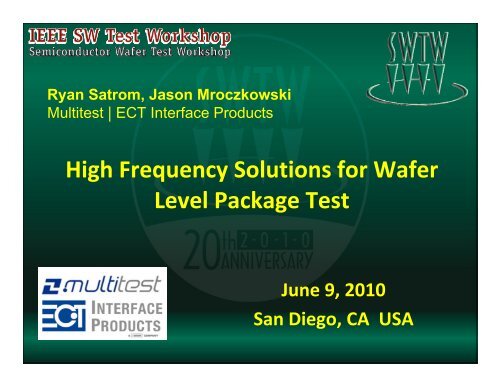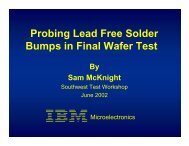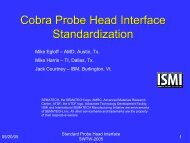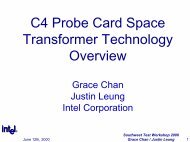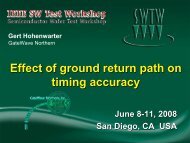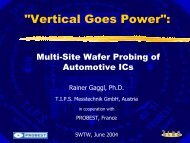High Frequency Solutions for Wafer Level Package Test
High Frequency Solutions for Wafer Level Package Test
High Frequency Solutions for Wafer Level Package Test
You also want an ePaper? Increase the reach of your titles
YUMPU automatically turns print PDFs into web optimized ePapers that Google loves.
Ryan Satrom, Jason Mroczkowski<br />
Multitest | ECT Interface Products<br />
<strong>High</strong> <strong>Frequency</strong> <strong>Solutions</strong> <strong>for</strong> <strong>Wafer</strong><br />
<strong>Level</strong> <strong>Package</strong> <strong>Test</strong><br />
June 9, 2010<br />
San Diego, CA USA
Drive Toward Final <strong>Test</strong> at <strong>Wafer</strong> <strong>Level</strong><br />
• <strong>Wafer</strong> <strong>Level</strong> Packaging Offers Low Cost, <strong>High</strong> <strong>Frequency</strong> solution<br />
– Eliminates second (package) test<br />
– Increased package pitch allows Pogo® pin architectures<br />
– Improved electrical per<strong>for</strong>mance compared to traditional packaging<br />
• <strong>Test</strong> Interface<br />
– Often per<strong>for</strong>mance limiter <strong>for</strong> tests at high frequency<br />
• <strong>High</strong>‐<strong>Frequency</strong> <strong>Test</strong>ing at <strong>Wafer</strong> <strong>Level</strong> Can Be Challenging<br />
– Successful solutions require signal integrity optimization<br />
– Optimization must include full test interface<br />
– <strong>Test</strong> hardware can be very costly<br />
Pogo® is a registered trademark of Everett Charles Technologies
New <strong>High</strong> <strong>Frequency</strong> WLP Solution<br />
• <strong>High</strong>‐frequency Pogo Pin Solution Addresses Challenge<br />
– PCB design guidelines <strong>for</strong> optimized signal integrity<br />
– Correct Pogo Pin <strong>for</strong> each specific application<br />
– Cost‐effective<br />
• Turnkey Solution Specific to <strong>High</strong>‐Speed WLP <strong>Test</strong> Market<br />
– Design<br />
– Simulation<br />
– Fabrication<br />
– Assembly
Agenda<br />
• Simulation‐Measurement Correlation<br />
– Both PCB and contactor<br />
– Ensures maximum simulation accuracy<br />
• <strong>Frequency</strong>‐Based PCB Design Guidelines<br />
– Provides rules based on frequency<br />
– Avoids unnecessary overdesign and additional costs<br />
• Hardware Selector Tool<br />
– Ensures per<strong>for</strong>mance specifications are met<br />
– Results based on application‐specific variables<br />
• Example Application
Simulation‐Measurement Correlation<br />
• Simulation Proven Through Extensive Characterization<br />
– Correlates simulation to measurement<br />
– <strong>Test</strong> hardware fabricated using Multitest manufacturing processes<br />
– Includes PCBs, contactors, and PCB/contactor interactions<br />
– Ensures simulation model accuracy<br />
RF Characterization<br />
Contactor<br />
RF Characterization PCB
PCB<br />
Correlation<br />
Contactor<br />
G<br />
S<br />
G<br />
• Microstrip traces<br />
• MER040<br />
• 1”, 4”, 6”<br />
• 0.4mm pitch<br />
• Nelco 4000‐13/SI<br />
• G‐S‐G Configuration<br />
MEASUREMENT<br />
SIMULATION
System Correlation<br />
• Stripline Trace to BTM080 Contactor<br />
– Includes via transition from PCB to contactor<br />
• Good Correlation out to 20GHz<br />
MEASUREMENT<br />
SIMULATION
Agenda<br />
• Simulation‐Measurement Correlation<br />
– Both PCB and contactor<br />
– Ensures maximum simulation accuracy<br />
• <strong>Frequency</strong>‐Based PCB Design Guidelines<br />
– Provides rules based on frequency<br />
– Avoids unnecessary overdesign and additional costs<br />
• Hardware Selector Tool<br />
– Ensures per<strong>for</strong>mance specifications are met<br />
– Results based on application‐specific variables<br />
• Example Application
PCB Design Guidelines<br />
• Design Rule Considerations<br />
– Typically derived from ideal environment<br />
– Often do not relate to actual per<strong>for</strong>mance<br />
– Rules valid below 500 MHz do not apply above 1 GHz<br />
• Design Rules Improved Through Simulation<br />
– Matched to application frequency<br />
– Ensures per<strong>for</strong>mance meets application requirements<br />
– Minimizes cost<br />
• Examples of Optimized Rules:<br />
– Connector footprints, stub drilling, ground via optimization<br />
(shown)<br />
– Relay/component footprints, trace spacing, component<br />
locations, etc.
PCB Design Guidelines – Connector Footprint<br />
• Datasheet Specification:<br />
– Bandwidth = 18.0 GHz<br />
• Simulation:<br />
– Top microstrip ‐1dB: 1.2 GHz (Standard); 2.9 GHz (Optimized)<br />
– Bottom microstrip ‐1dB: 1.9 GHz (Standard); 6.2 GHz (Optimized)<br />
• Optimized Footprints Now Used as Design Standard
PCB Design Guidelines –Stub Drilling<br />
• Stubs<br />
– Create undesired noise in signal path<br />
– Creates signal reflections that limit bandwidth<br />
• Stub Drilling<br />
– Removes undesired stubs from signal paths<br />
– Becomes increasingly important as frequencies increase
PCB Design Guidelines –Stub Drilling<br />
• Stub Drilling ‐ Rule of Thumb:<br />
– Stub length must be less than ¼‐wavelength of max frequency<br />
• Simulation Results:<br />
– Stub drill required well below ¼‐wavelength frequency<br />
– Required in GHz range<br />
– Much less dependent of signal layer than ¼‐wave <strong>for</strong>mula<br />
suggests<br />
Backdrill Recommendations<br />
LYR<br />
Stub Len<br />
(mil)<br />
¼-λ<br />
Equation<br />
Bandwidth<br />
(-1dB)<br />
Lyr03 234 6.5 GHz 1.9 GHz<br />
Lyr11 167 9.1 GHz 2.3 GHz<br />
Lyr22 83 18.2 GHz 2.4 GHz<br />
Lyr30 17 89.1 GHz 2.3 GHz
PCB Design Guidelines – Ground Via<br />
• Ground Via Proximity –Rule of Thumb:<br />
– No standard design rules <strong>for</strong> ground via location<br />
• Simulation Results:<br />
– Ground via location have significant impact on per<strong>for</strong>mance<br />
– Design rules created based on frequency
PCB Design Guidelines – Summary<br />
• Connector Manufacturer Specifications are not Accurate<br />
• Quarter‐Wavelength Stub Drill Approximation Insufficient<br />
• Design Rules Require 3D Simulation<br />
– Accounts <strong>for</strong> all necessary variables:<br />
• PCB Thickness<br />
• Signal Layer<br />
• Ground Via Proximity<br />
• Stub Length
Agenda<br />
• Simulation‐Measurement Correlation<br />
– Both PCB and contactor<br />
– Ensures maximum simulation accuracy<br />
• <strong>Frequency</strong>‐Based PCB Design Guidelines<br />
– Provides rules based on frequency<br />
– Avoids unnecessary overdesign and additional costs<br />
• Hardware Selector Tool<br />
– Ensures per<strong>for</strong>mance specifications are met<br />
– Results based on application‐specific variables<br />
• Example Application
PCB Material & Contactor Selection<br />
• Factors impacting <strong>High</strong> <strong>Frequency</strong> Hardware<br />
Selection<br />
– PCB material<br />
– Trace topology<br />
– Trace length<br />
– Device pitch<br />
– Signaling type –single‐ended or differential<br />
– Ground‐signal configuration –G‐S, G‐S‐G, G‐S‐S‐G<br />
• Multitest Hardware Selection Tool<br />
– Accounts <strong>for</strong> all relevant variables
PCB Selection Parameters<br />
• Trace Topology<br />
– Stripline (Internal) , Microstrip (External)<br />
• Trace Length<br />
– 2”, 4”, 8”, 12”, 16”
Contactor Selection Parameters<br />
• Pitch<br />
– 0.3mm, 0.4mm, 0.5mm<br />
– As pitch increases, impedance increases<br />
• Ground Configuration<br />
– Signal Type<br />
• Single‐ended (G‐S, G‐S‐G) –one signal trace<br />
• Differential (G‐S‐S‐G) –two signal traces<br />
– Number of adjacent grounds<br />
• G‐S, G‐S‐G<br />
• As number of grounds increases, impedance<br />
decreases
Agenda<br />
• Simulation‐Measurement Correlation<br />
– Both PCB and contactor<br />
– Ensures maximum simulation accuracy<br />
• <strong>Frequency</strong>‐Based PCB Design Guidelines<br />
– Provides rules based on frequency<br />
– Avoids unnecessary overdesign and additional costs<br />
• Hardware Selector Tool<br />
– Ensures per<strong>for</strong>mance specifications are met<br />
– Results based on application‐specific variables<br />
• Example Application
Application Example<br />
• Example<br />
– 48 QFN, 0.5 mm pitch, 7x7 mm<br />
– Application: Gigabit Ethernet Controller<br />
– 2.5 Gbit/s Differential PCI‐express<br />
• Requires 3.75 GHz bandwidth (3 rd harmonic)<br />
• Goal –Meet Application <strong>Frequency</strong> Requirements<br />
– Determine connector type<br />
– Determine if stub drill is required<br />
– Select optimal PCB material<br />
– Select optimal Pogo pin <strong>for</strong> contactor
Application Example – Connector Type<br />
• Requires 3.75 GHz bandwidth<br />
• Connector choice<br />
– Surface mount, right‐angle, top‐launch SMA connector<br />
– Allows <strong>for</strong> backdrill<br />
– Minimizes loss without use of high‐cost connector<br />
Connector Type<br />
Loss @<br />
3.75GHz<br />
Bandwidth<br />
(-1dB)<br />
<strong>High</strong>-Cost Surface<br />
SMA<br />
0.1dB 15.0 GHz<br />
Med-Cost Surface<br />
SMA<br />
0.1dB 11.1 GHz<br />
Thru-Hole SMA 1.2dB 2.9 GHz
Application Example – Stub Drill<br />
• Stub Drill Not Necessary at DUT or at Connector<br />
• Per<strong>for</strong>mance Stays Within Loss Budget (‐3dB) Without Stub Drill<br />
• Recommendation<br />
– Use high‐aspect ratio drilling at DUT<br />
– Eliminates the need <strong>for</strong> sequential lamination
Application Example –PCB Material<br />
• Majority of Loss Due to PCB Trace<br />
• Recommendation –Nelco 4000‐13<br />
– Good high‐speed material<br />
– Meets per<strong>for</strong>mance requirements without expense<br />
of exotic material<br />
PCB Material<br />
FR4<br />
Nelco 4000-13<br />
Rogers 4003<br />
Loss @<br />
3.75GHz<br />
2.8dB<br />
2.1dB<br />
1.6dB
Application Example –PCB & Contactor<br />
• Application<br />
Specifications<br />
– 0.5mm<br />
– GSSG (Differential)<br />
– Stripline<br />
– 8” PCB Trace<br />
• Nelco 4000‐13<br />
• MER050 is best<br />
solution<br />
– System Bandwidth<br />
(‐3dB) is greater<br />
than 3.75GHz
System Per<strong>for</strong>mance<br />
• SMA Connector → 8” Stripline → MER050 Contactor<br />
• System Bandwidth (‐3dB): 3.9 GHz
Conclusion<br />
• A new WLP high frequency solution is<br />
available<br />
• Multitest Solution Uses:<br />
– Simulation and Characterization<br />
– PCB design recommendations based on<br />
high frequency 3D electromagnetic<br />
simulation<br />
– Hardware selection tool to fit the needs of<br />
each customer specific application


